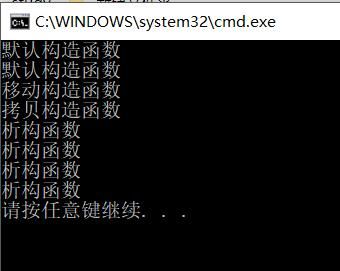1 #include<iostream> 2 #include<vector> 3 #include<string> 4 using namespace std; 5 6 class Test 7 { 8 public: 9 Test(const string& s = "hello world") :str(new string(s)) { cout << "默认构造函数" << endl; }; 10 Test(const Test& t); 11 Test& operator=(const Test& t); 12 Test(Test&& t) noexcept; 13 Test& operator=(Test&& t) noexcept; 14 ~Test(); 15 public: 16 string * str; 17 }; 18 19 Test::Test(const Test& t) 20 { 21 str = new string(*(t.str)); 22 cout << "拷贝构造函数" << endl; 23 } 24 Test& Test::operator=(const Test& t) 25 { 26 cout << "拷贝赋值运算符" << endl; 27 return *this; 28 } 29 Test::Test(Test&& t)noexcept 30 { 31 str = t.str; 32 t.str = nullptr; 33 cout << "移动构造函数" << endl; 34 } 35 Test& Test::operator=(Test&& t)noexcept 36 { 37 cout << "移动赋值运算符" << endl; 38 return *this; 39 } 40 Test::~Test() 41 { 42 cout << "析构函数" << endl; 43 } 44 45 int main() 46 { 47 vector<Test> vec(1); 48 Test t("what"); 49 vec.push_back(std::move(t)); 50 return 0; 51 }
运行结果:
首先说说为什么会这样输出:
1、第一个 “默认构造函数” 是因为vector<Test> vec(1) , 所以事先使用默认构造函数构造了一个Test对象
2、第二个 “默认构造函数” 是因为Test t ,使用默认构造函数构造了一个对象
3、第三个 “移动构造函数” 大多数人会以为是 vec.push_back(std::move(t)) ,push_back 导致对象的移动而输出的。具体的原因其实是由于重新分配内存而导致的,我们的 vector 对象 vec 初始的容量只有 1 ,且里面已经有一个对象了,就是vector<Test> vec(1)的时候创建的,所以再向vec里面添加Test对象时,就会导致vec重新分配内存。由于vec中的对象定义了移动构造函数且是可用的(因为我们将其声明为了noexcept),所以就会调用移动构造函数将vec中原始的那个对象移动到新的内存中,从而输出 “移动构造函数”。
4、第四个 “移动构造函数” 才是因为Test 对象 t 被移动到vector 对象 vec 新的空间而输出的
5、第五个 “析构函数” 是因为重新分配内存后,原来的内存将被销毁,所以输出一个“析构函数”
6、后面三个 “析构函数” 是因为执行了return 0, 内存被释放,vec 和 t 都被析构,所以输出三个 “析构函数”
将 Test.h 和 Test.cpp 文件中的noexcept 都删去,输出的结果变成了:

更改之后的输出只有第四行的输出变了,其余行输出原因与上面是一样的
第四行的输出由 “移动构造函数” 变成了 “拷贝构造函数” ,原因是:
由于我们的移动构造函数没有声明为noexcept,所以我们的移动构造函数就会被认为是可能抛出异常,所以在重新分配内存的过程中,vec 对象就会使用拷贝构造函数来“移动”对象(这里说的移动其实是拷贝,并不是移动),所以就输出了“拷贝构造函数”。